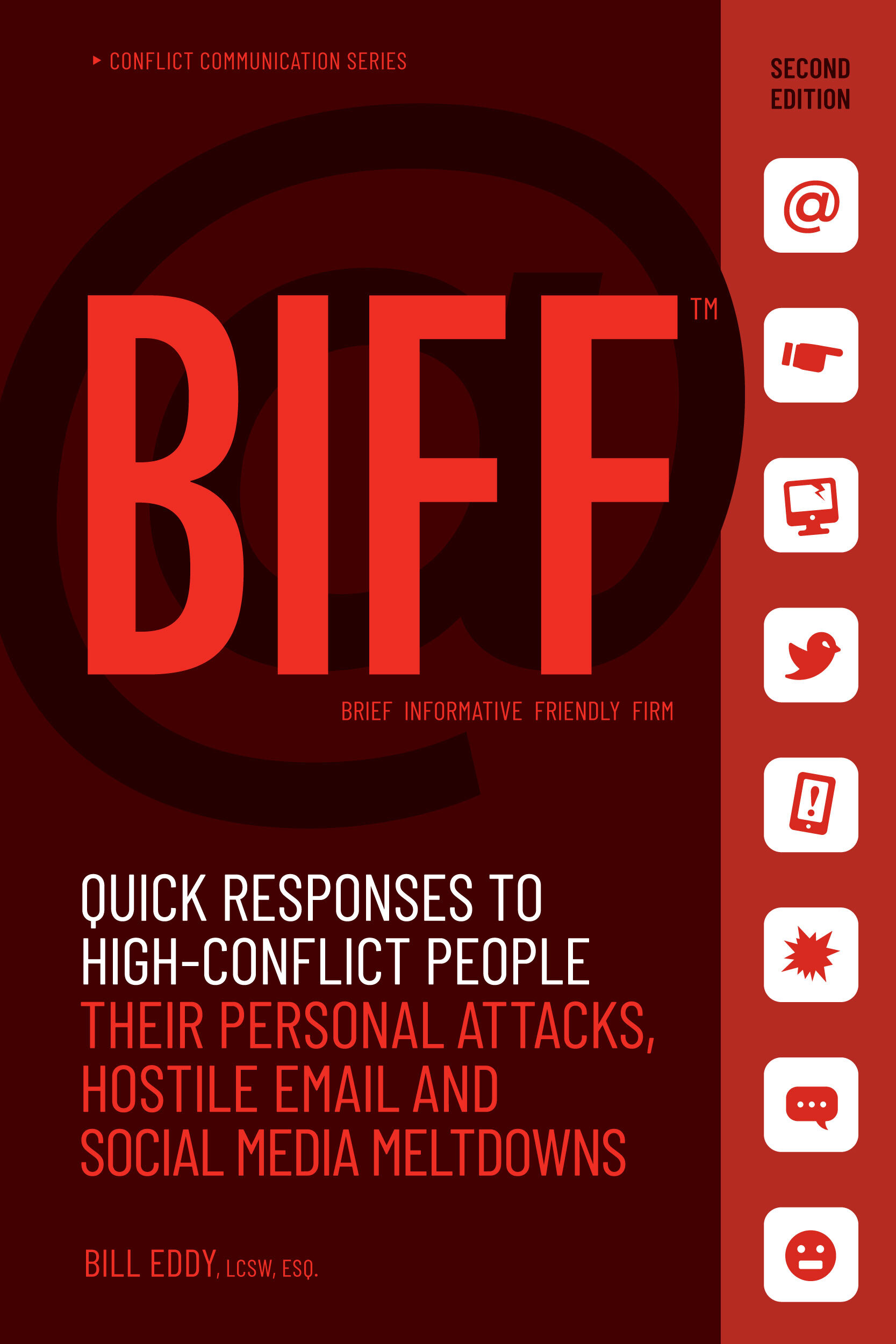BIFF for Lawyers and Law Offices
Your Guide to Respectful Written Communication with Clients, Opposing Counsel and Others
Bill Eddy, LCSW, Esq.
Rehana Jamal, JD, LL.M.
Your Guide to Respectful Written Communication with Clients, Opposing Counsel and Others
Bill Eddy, LCSW, Esq.
Rehana Jamal, JD, LL.M.
Your Guide to Respectful Written Communication with Clients, Opposing Counsel and Others
Bill Eddy, LCSW, Esq.
Rehana Jamal, JD, LL.M.
Available in print (click above) or as an e-book (digital) through our secure partner, BookBaby.
BIFF FOR LAWYERS AND LAW FIRMS: Your Guide to Respectful written communication with clients, opposing counsel and others
is in our Conflict Communication Series.
Description
This book provides a simple and proven method for lawyers to use in ethically responding to hostile communications, correcting misinformation by others, and initiating productive correspondence. This method can be used by all law office personnel (paralegals, administrative assistants, receptionists, and others), with 30 sample responses to common situations involving hostile or misinformed emails, text messages, and other forms of communication. BIFF stands for Brief, Informative, Friendly, and Firm.
The BIFF method can also be taught to clients to help them write friendly and concise responses in their legal cases, which saves lawyers time and reduces the escalation of unnecessary conflicts in their cases. This book explains how to coach office staff, clients and their family members to use the BIFF method, including ten easy key questions to ask when reviewing their correspondence. While this method is designed primarily for written communication, this approach can also be used in verbal conversations, to be efficient and respectful.
The book is divided into five sections:
Learning the BIFF Method
Correspondence with Clients
Correspondence with Colleagues
Correspondence with Staff and Between Staff
Coaching staff and clients in the BIFF method.
Each sample scenario provides a hostile correspondence received by the lawyer and/or staff member; then gives a tempting response which is not quite a BIFF (analyzed using the BIFF Checker); then gives a communication that is a BIFF.
Book Details
Publication date: January 2, 2024
Pages: 207
Binding: Paperback
ISBN (print): 978-1950057399
ISBN (ebook): 978-1950057405
Authors: Bill Eddy, LCSW, Esq. and Rehana Jamal, JD, LL.M.
Series: Conflict Communication Series #5
The Authors
BILL EDDY is a lawyer, therapist, mediator, and the co-founder and training director of the High Conflict Institute. He was The Senior Family Mediator at the National Conflict Resolution Center for 15 years, a Certified Family Law Specialist lawyer representing clients in family court for 15 years, and a Licensed Clinical Social Worker therapist with twelve years of experience. Currently he serves on the faculty of the Straus Institute for Dispute Resolution at the Pepperdine University School of Law in California and is a Conjoint Associate Professor with the University of Newcastle Law School in Australia. He has been a speaker and trainer in over 30 U.S. states and 10 countries. He is the author or co-author of sixteen books and has a popular blog on the Psychology Today website with over 5 million views. Bill lives in San Diego, California with his wife.
REHANA JAMAL is a conflict resolution specialist, mediator, and lawyer. Rehana holds an LL.M. in dispute resolution from Pepperdine Law School, a J.D. from Cardozo School of Law, and is a member of the New York State Bar. Her B.A. is in psychology from Barnard College, Columbia University. She has tremendous experience and passion working with people from different cultural, sociopolitical, and economic backgrounds from her experience living abroad in Ecuador, Colombia, Kenya, and Spain. She is an avid traveler. She has always been fascinated by the way in which people interact, particularly in the way they communicate and navigate difficult conversations, which led her to pursue an undergraduate degree in psychology and, thereafter, a career in law and conflict resolution.










